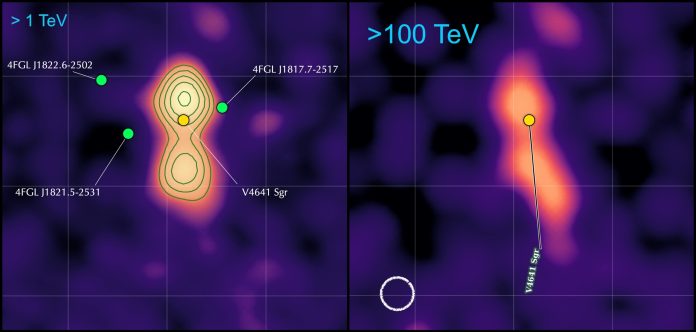
For a long time, astronomers believed that extremely high-energy radiation was produced only in the jets of active galaxies, far from Earth.
But new observations from the High-Altitude Water Cherenkov (HAWC) Gamma-Ray Observatory suggest that powerful cosmic radiation can also come from much closer sources within our own galaxy, specifically from objects known as microquasars.
Microquasars are compact systems made up of a massive star and a black hole.
These black holes pull in material from their companion star, creating swirling disks of hot matter.
This process launches narrow, powerful jets of energy into space at speeds close to the speed of light. One of these microquasars, called V4641 Sagittarii, lies about 20,000 light-years away in the direction of the Sagittarius constellation.
It has now been identified as a source of extremely high-energy gamma rays, with photon energies reaching up to 200 teraelectronvolts (TeV)—an energy level far beyond what is typically observed from other microquasars.
The discovery came as a surprise to researchers. Previously, it was thought that such high-energy radiation was only possible in the jets of supermassive black holes in distant quasars.
Quasars are active galactic centers powered by supermassive black holes, millions of times more massive than our Sun, located hundreds of millions of light-years away.
These jets are known to produce powerful radiation, including gamma rays, as they interact with surrounding matter.
However, V4641 Sagittarii, a much smaller system, has shown it can generate gamma rays of comparable energy, challenging previous beliefs.
HAWC, located in Mexico, uses 300 large water tanks to detect particles and gamma rays coming from space.
When high-energy particles pass through the water, they create a brief flash of light known as Cherenkov radiation, which the HAWC detectors capture. By analyzing these flashes, researchers can determine the energy and source of incoming cosmic rays.
What makes V4641 Sagittarii especially interesting is that its jet points directly toward Earth, creating a unique effect where parts of the jet seem to move faster than light (a phenomenon known as superluminal motion).
While nothing can actually exceed the speed of light, this effect happens because of the way light travels from the moving jet toward us. This unusual alignment provides Earth-based scientists with an excellent opportunity to study these powerful jets in real time and without the distortions caused by vast cosmic distances.
Dr. Sabrina Casanova from the Institute of Nuclear Physics of the Polish Academy of Sciences led the study and emphasized that V4641 Sagittarii is not the only microquasar showing such high energy. Other microquasars, observed by similar observatories like LHAASO in China, also appear to emit very high-energy photons, suggesting that these objects could be major sources of cosmic rays within our galaxy.
This discovery opens up exciting possibilities for studying cosmic radiation up close. Microquasars offer a unique way to observe processes similar to those in distant galaxies on a much faster and more accessible timescale.
Unlike radiation from faraway quasars, which must travel millions of light-years and may lose energy along the way, radiation from nearby microquasars reaches Earth relatively undisturbed.
This means scientists can now explore the physics of high-energy jets with far greater clarity, enhancing our understanding of how these cosmic powerhouses shape galaxies.
Source: KSR.



